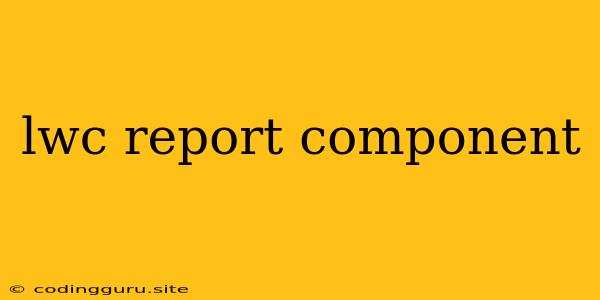Unleashing the Power of LWC Report Components: A Comprehensive Guide
Lightning Web Components (LWC) have revolutionized the way Salesforce developers build applications. With their powerful features and flexibility, LWC empowers developers to craft dynamic and interactive user experiences. Amongst these features, LWC report components stand out as a game-changer for data visualization and analysis within Salesforce.
Let's dive deep into the world of LWC report components and explore their capabilities, benefits, and best practices.
What are LWC Report Components?
LWC report components are custom components built using Lightning Web Components framework. They provide a powerful mechanism to seamlessly integrate Salesforce reports within your Lightning Experience (LEX) pages. These components allow you to display report data in a visually appealing and interactive manner, enhancing your users' ability to analyze and understand information.
Why Use LWC Report Components?
LWC report components offer a multitude of advantages over traditional Salesforce report viewing:
- Enhanced User Experience: LWC report components provide a modern and interactive experience for users to explore data. You can customize the component's appearance, layout, and functionality to meet your specific needs.
- Flexibility and Customization: LWC components are highly flexible, allowing you to tailor the report presentation to your users' preferences. You can choose to display specific fields, apply filters, and even add custom functionalities to enhance data analysis.
- Improved Data Visualization: LWC report components offer opportunities to go beyond basic table views. You can leverage charts, graphs, and other visual elements to represent data effectively and make insights more accessible.
- Code Reusability: LWC report components are reusable components, meaning you can use them across multiple pages and applications within Salesforce. This promotes efficiency and reduces development time.
Building Your First LWC Report Component
Creating a LWC report component is a straightforward process. Let's break down the essential steps involved:
- Create a New LWC Component: Begin by creating a new Lightning Web Component in your Salesforce org.
- Define the Component's Attributes: Specify the necessary attributes for your component. This may include the report ID, desired layout, or other customizations.
- Fetch Report Data: Use the Salesforce Apex API to fetch the report data based on the provided report ID and any specified filters.
- Render the Data: Utilize the LWC template to render the fetched report data. Choose appropriate HTML elements and styles for visual presentation. You can use pre-built LWC datatables or create your own custom layouts.
- Add Interactivity: Incorporate event handling and user interactions to enhance the component's functionality. For example, you might add sorting or filtering capabilities or allow users to drill down into specific data points.
Real-World Examples of LWC Report Components
Here are some real-world examples of how LWC report components can be used:
- Sales Dashboard: Create a LWC report component that displays a summary of sales pipeline performance. You can use charts and graphs to highlight key metrics like conversion rate, average deal size, and deal stage distribution.
- Customer Segmentation Analysis: Develop a component that visualizes customer segmentation based on demographics, purchase history, or other criteria. Use different chart types like bar charts, pie charts, or heat maps to present the analysis effectively.
- Project Progress Tracker: Create a LWC report component that shows the progress of various projects within your organization. Use a Gantt chart or other visualization methods to display tasks, deadlines, and resource allocation.
Best Practices for Creating LWC Report Components
To ensure that your LWC report components function efficiently and meet the expected standards, follow these best practices:
- Optimize Performance: Minimize the amount of data fetched from Salesforce to improve component loading times. Consider using pagination or limiting the number of rows displayed.
- Ensure Accessibility: Design your components to be accessible to all users. Use ARIA attributes and follow web accessibility guidelines.
- Maintain Code Quality: Write clean, modular, and well-documented code to facilitate maintainability and collaboration.
- Follow Security Best Practices: Implement appropriate security measures to protect sensitive data. Use Salesforce's security framework and follow best practices for secure coding.
Conclusion
LWC report components offer a powerful and flexible way to enhance data analysis and visualization within Salesforce. By leveraging the benefits of Lightning Web Components, developers can create interactive and engaging dashboards, reports, and custom tools to empower users to make better decisions. As you continue your journey with LWC, exploring the potential of LWC report components will unlock new avenues for transforming your Salesforce applications and delivering exceptional user experiences.
